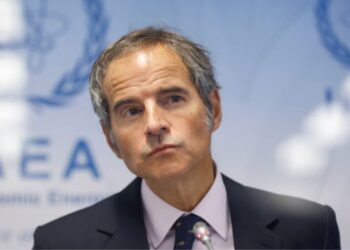Emmanuel Macron proposed on Tuesday a decarbonization pact to the most CO2-emitting industrialists in France with a doubling of public aid to 10 billion euros in exchange for a
double their effort in this area.
“If projects and sites are identified within 18 months, if you double your efforts, if we manage to move from 10 million tons of CO2 avoided to 20 million instructed, we will double the means devoted to this issue and increase the envelope from 5 to 10 billion euros of support, “said the head of state to the industrialists gathered at the Elysee.
To achieve this effort, the head of state, just back from the world climate conference (COP27) in Sharm el-Sheikh, Egypt, also announced that the government would develop a precise planning in six months and in the years to come, “sector by sector”.
Cement, aluminum, steel, fertilizer, sugar or fuel: the heads of the fifty French industrial sites that emit the most CO2, including the CEO of TotalEnergies Patrick Pouyanné, were received in the Elysée’s reception room.
These 50 sites alone represent 30,000 jobs and half of the industry’s emissions, or 10% of the country’s emissions. “The goal is to halve the greenhouse gas emissions of these sites in ten years, thus removing 5% of French emissions,” explains the Elysée.
These include the steel plants of Arcelor Mittal in Dunkirk or Fos-sur-Mer, the cement plants of Vicat, Lafarge or Calcia, chemical plants in the Grand Est, the Etang de Berre or Normandy, and the fertilizer manufacturers Yara or Borealis, the Arcques glassworks, the ExxonMobil and TotalEnergies refineries in Normandy, Air Liquide in the PACA region, and the sugar production sites of Tereos and Cristal Union in northern France.
Emmanuel Macron has insisted on his desire to accelerate the fight against climate change, after a first five-year term considered too timid in this area by environmental specialists. But also to reindustrialize. “Decarbonation is one of the elements that should allow us to
continue to create industrial jobs,” he said.
Not friendly
The head of state especially pointed to the exacerbated competition from economic powers such as the United States, which promise massive public subsidies for decarbonization, with a risk of deindustrialization if Europeans do not follow.
“The United States is a producer of cheap gas that they sell at a high price, and in addition they have taken massive aid measures in certain sectors,” he said.
“This is not in line with WTO rules and it is not friendly,” he insisted, promising to put the issue on the table during his state visit in early December in Washington.
Addressing industrialists, he asked that “ecological transition contracts” be signed to set in stone the promised efforts, site by site, and sector by sector, under the aegis of the Minister of Industry.
“We will put online the map of France of the 50 sites” most emitting CO2 to monitor progress, he promised in front of a giant map of France showing the emissions, where stand out the north of France with 12 million tons of CO2 emitted, followed by the basin of Marseille-Fos with
a little over 10 million tons of CO2, and the mouth of the Seine in Normandy.
The additional five billion euros announced on Tuesday are in addition to the five billion already provided for in the France Relance plan for the decarbonization of industry. France has also earmarked nine billion euros of investment for the development of hydrogen, which is one of the powerful vectors for decarbonizing industry.
It is necessary “within six months that the government can present a plan to integrate” these amounts “in the work of multi-year programming of energy”, said the president.
The planning will have to be done “by technology”, he said, mentioning hydrogen – which will be used in particular by the steel industry to replace coal -, the development of biomass to replace gas, the electrification of sea and river ports for the transport of goods, or the capture and reuse of CO2.
During various presentations, the industrialists present insisted on having access to a “stable” and “massive” source of electricity, while the technical problems of EDF in its nuclear power plants are still far from being resolved.






